Evacuation experiences of older adults during armed conflict: Community, place attachment, and well-being
IF 7
1区 心理学
Q1 ENVIRONMENTAL STUDIES
引用次数: 0
Abstract
Evacuation is defined as an organized, temporary removal of people from a place of danger to a place of safety, typically in response to emergencies, whereas displacement generally lacks prospects for an immediate return, contributing to feelings of collective trauma.
This study investigates the experiences of older adults displaced from northern Israeli settlements due to the Israel-Hamas conflict in October 2023, focusing on their connection to place, community, and the psychological impact of forced evacuation. Using a phenomenological approach, 16 participants aged 65 and above were interviewed to understand their attachment to community and sense of belonging in the context of forced relocation. Findings revealed two main themes: (1) social ties as a protective force, where evacuees report strengthened connections within new “hotel communities” or among previous community members relocated together; and (2) a deep emotional and identity-based bond to their original settlement, now perceived as more complicated connections. Community cohesion emerged as a critical factor in emotional resilience, while dislocation and aging complicate perceptions of return. This study highlights the importance of social bonds (those from home settlement and those created after evacuation) in maintaining mental health during crises and suggests the need for policies that prioritize community cohesion and support systems in displacement and evacuation scenarios. These findings underscore the significant role of social infrastructure in coping with and potentially mitigating the adverse effects of forced evacuation on older adults.
武装冲突中老年人的疏散经历:社区、地方依恋和幸福感
疏散被定义为有组织地将人们从危险地点暂时转移到安全地点,通常是为了应对紧急情况,而流离失所通常缺乏立即返回的前景,造成集体创伤感。本研究调查了由于2023年10月以色列-哈马斯冲突而从以色列北部定居点流离失所的老年人的经历,重点关注他们与地方、社区的联系以及被迫撤离的心理影响。采用现象学方法,对16名65岁及以上的参与者进行了访谈,以了解他们在被迫搬迁背景下对社区的依恋和归属感。研究结果揭示了两个主要主题:(1)社会关系作为一种保护力量,撤离者报告说,他们与新的“酒店社区”或以前一起搬迁的社区成员之间的联系加强了;(2)与他们最初的居住地有着深厚的情感和基于身份的联系,现在被认为是更复杂的联系。社区凝聚力成为情绪弹性的关键因素,而错位和老龄化使回归的观念复杂化。这项研究强调了社会关系(来自家庭定居和疏散后建立的社会关系)在危机期间维持心理健康的重要性,并建议需要制定政策,优先考虑流离失所和疏散情景中的社区凝聚力和支持系统。这些发现强调了社会基础设施在应对和可能减轻强制疏散对老年人的不利影响方面的重要作用。
本文章由计算机程序翻译,如有差异,请以英文原文为准。
求助全文
约1分钟内获得全文
求助全文
来源期刊

Journal of Environmental Psychology
Multiple-
CiteScore
10.60
自引率
8.70%
发文量
140
审稿时长
62 days
期刊介绍:
The Journal of Environmental Psychology is the premier journal in the field, serving individuals in a wide range of disciplines who have an interest in the scientific study of the transactions and interrelationships between people and their surroundings (including built, social, natural and virtual environments, the use and abuse of nature and natural resources, and sustainability-related behavior). The journal publishes internationally contributed empirical studies and reviews of research on these topics that advance new insights. As an important forum for the field, the journal publishes some of the most influential papers in the discipline that reflect the scientific development of environmental psychology. Contributions on theoretical, methodological, and practical aspects of all human-environment interactions are welcome, along with innovative or interdisciplinary approaches that have a psychological emphasis. Research areas include: •Psychological and behavioral aspects of people and nature •Cognitive mapping, spatial cognition and wayfinding •Ecological consequences of human actions •Theories of place, place attachment, and place identity •Environmental risks and hazards: perception, behavior, and management •Perception and evaluation of buildings and natural landscapes •Effects of physical and natural settings on human cognition and health •Theories of proenvironmental behavior, norms, attitudes, and personality •Psychology of sustainability and climate change •Psychological aspects of resource management and crises •Social use of space: crowding, privacy, territoriality, personal space •Design of, and experiences related to, the physical aspects of workplaces, schools, residences, public buildings and public space
 求助内容:
求助内容: 应助结果提醒方式:
应助结果提醒方式:


